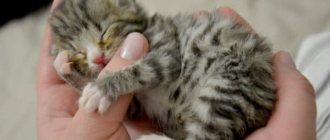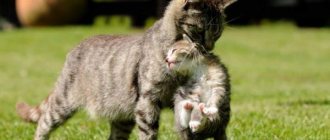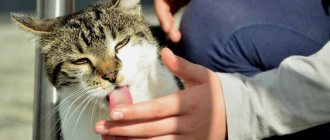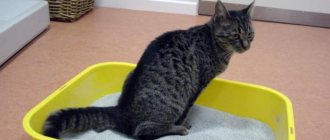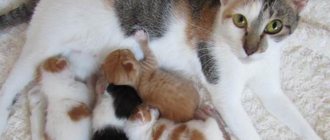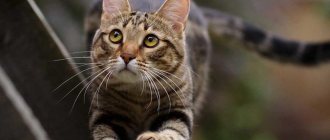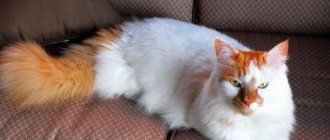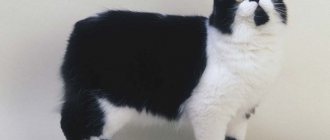Raising and caring for kittens is a responsible and difficult mission for a young cat mother. Nature has provided a lot, but sometimes human intervention in the feeding process is necessary. In the material you will learn about the nutritional features of newborn kittens, the timing and frequency of feeding. We talked about the intricacies of caring for a nursing cat, possible problems and ways to solve them. Also from the article you will learn what to do if a cat abandoned and does not feed her kittens.
Mother's milk is important for kittens from the first hours of life
Feeding kittens with a cat - features
From birth to one month old, kittens receive the necessary substances from their mother’s milk. On the first day after giving birth, the cat feeds the kittens colostrum, a useful substance that strengthens the babies’ immunity from the first hours of their life. Provided that the cat is healthy and has enough milk, at first the kittens will gain about 10 grams daily. The best thing an owner can do to help a nursing pet during this period is to provide increased nutrition and a sense of security.
Mother cat with her kittens
How often does feeding occur?
The first hours of life, kittens feed intensively. Within 16 hours after birth, a cat produces colostrum, a liquid containing antibodies that strengthen the immune system, so receiving it is important for newborns.
Until the babies are a week old, the cat feeds the kittens 10 times a day. From the second week, meals are reduced to 8 times, or every 2-3 hours. After a month, feeding occurs 5-6 times a day.
What determines the timing of feeding?
The timing of feeding depends on the condition of the animal and the resources of its body. This is influenced by nutrition, diseases and postpartum complications, and the number of kittens born.
Can kittens have milk from a cow?
If, for a number of reasons, a kitten can no longer feed on mother’s milk, the owner is faced with the task of choosing the most suitable analogue. The first thing that comes to mind is cow's milk. This product is widely represented on the market, it is affordable and can be found in any store. But can you give it to a kitten? Unfortunately, there are many reasons why this choice should be abandoned.
Cow's milk is intended for newborn calves. Its composition is rich in vitamins and beneficial microelements, many of which are suitable for cat babies. But some substances are not needed by the kitten’s body and are even dangerous:
- the protein contained in cow's milk can cause diarrhea or allergies;
- estrogen is a female hormone present in the milk of a pregnant cow, which negatively affects the kitten’s hormonal levels;
- antibiotics that cows receive on farms can cause dysbiosis;
- Some of the pesticides contained in cow feed end up in the milk and can cause severe poisoning in a kitten;
- pasteurized dairy products from the store are practically devoid of nutrients and beneficial substances.
Feeding with cow's milk
Nutrition
The postpartum period is difficult for a cat: in addition to the need to produce milk, the body experiences stress from recent pregnancy and childbirth. Increasing food portions alone is not enough. The diet of a cat nursing newborn kittens must be balanced and contain vitamins and substances necessary for health. If the animal receives nutrition in the same proportions as before pregnancy, milk may quickly run out.
Monitor the diet of the young mother. It’s better to leave fast food for the owners.
Features of goat milk
Goat's milk is better for kittens than cow's milk. Its composition is more acceptable to their body.
Goat milk has a number of undoubted advantages over cow milk:
- in terms of fat content it is closer to cat fat;
- fats and proteins are easily digestible;
- low-allergenic;
- contains less lactose;
- contains a lot of lacto- and bifidobacteria, which have a positive effect on the intestinal microflora and the digestive process;
- a significantly higher percentage of vitamins and mineral compounds.
If there are no contraindications, kittens can be given goat's milk. To reduce the fat content, it must first be diluted with water.
It is very important to buy the product from trusted farmers, making sure in advance that the goats are healthy, well-nourished and kept in decent conditions.
Number of kittens in litter
How long a cat can feed kittens with her milk depends on the number of newborns. The more offspring a cat has, the faster milk will cease to be produced. The number of nipples allows the cat to feed 6 kittens at the same time. If there are more kittens, then the weakest ones will be malnourished, and the capabilities of the mother’s body will quickly dry up. If the litter is small (2-3 kittens), then the feeding time will increase.
The larger the offspring, the more difficult it is to feed it
A healthy cat that receives good nutrition, does not have serious postpartum complications and has an excessively large litter, can feed its offspring for up to 2-2.5 months. Depending on the factors mentioned, these timings may vary.
Not enough milk - what to do?
You can tell if kittens are not getting enough milk by their behavior. Hungry kittens constantly squeak, looking for their mother's nipple. If the owner has any doubts, weighing the offspring daily will help. In the first weeks of life, kittens gain an average of 10 grams.
Hungry kittens will squeak and look for their mother's nipple
What to do if your fears are confirmed and there is not enough milk? Take care of the cat first. There can be many reasons for a lack of milk: stress, complications after childbirth, illness, insufficient food. Provide your cat family with a cozy and safe place and constant access to food and water. Place the bowls close to the cat: in the first days after giving birth, she may be afraid to leave her offspring.
Along with enhanced cat care, don’t forget about kittens. They cannot starve, so the owner will have to take charge of feeding them.
How to introduce complementary foods
By the age of three weeks, kittens begin to show interest in food. If the mother is nearby, then she herself will take her offspring to the bowl and set an example, and the kittens will try to imitate her. But what if the cat abandoned her kittens?
The kitten will not begin to feed on its own right away: it is difficult for him to learn to lap without a mother’s example. Therefore, introduce complementary foods on your finger or spoon. This should be liquid food, for example:
- baby food;
- vegetable and meat porridges;
- low-fat cottage cheese with added milk;
- semolina porridge without sugar.
Make sure that there are no additives or spices in complementary foods. After the kitten gets used to complementary foods, add boiled egg yolk to the menu. It is best to mash it and add it to porridge.
Replacing milk with fermented milk products
If the cat is a dairy lover and is on a natural diet, it is better to gradually replace this product with a fermented milk menu.
Kefir, fermented baked milk, natural yoghurts not only do not contain milk sugars, but are also enriched with lactic acid bacteria, which have a beneficial effect on digestion and the functioning of the entire gastrointestinal system of the cat as a whole.
There is no lactose in these products; it is what is converted into lactic acid during fermentation.
Using various types of fermented milk products, you can regulate and eliminate intestinal problems in your pet. So, for example, in case of regular constipation, fresh kefir will help, and in case of diarrhea, “old” (two-day old) kefir.
You can offer your cat milk without or with low lactose content, but usually such products do not delight your pet.
When choosing kefir, or better yet biokefir or fermented baked milk, you should pay attention to the fat content in them. It shouldn't be high. That is why you should not often offer your cat high-calorie cottage cheese or cheese, much less sour cream.
It is unacceptable to feed your pet sweet yoghurts and curds containing a lot of sucrose. Sugar is another harmful and dangerous human product for cats.
Cat food during the kitten feeding period
During the postpartum period, the cat's nutrition should be enhanced and balanced. Its recovery and milk production will depend on the quality of nutrition. The volume of portions is determined by the needs of the animal. On average, in the first 3 weeks it doubles. Since kittens are introduced to complementary foods after 3 weeks of age, portion sizes for the cat are gradually reduced.
In the first two days, the cat may refuse to eat and drink only water. This is no cause for concern. Firstly, the cat gets very tired after giving birth, and secondly, she could get enough of the afterbirth. To keep your cat cozy, place a bowl of food and water close to her so she doesn't have to leave her babies.
The diet of a nursing cat should be balanced
What to feed a cat during the postpartum period? In the first 12 days after birth, feed your cat easily digestible and natural food. The menu may include:
- dairy products;
- vegetable and cereal porridges;
- a small amount of boiled lean meat.
Gradually introduce familiar foods to the menu.
Artificially bred breeds (Elf, Savannah, Chausie, American Curl), as well as British dogs, are very susceptible to changes in diet, so it is better to leave their menu unchanged.
If before giving birth the cat was fed commercial food, then after the birth of the offspring, switch it to food marked “for nursing cats.” These foods contain everything your pet needs; the required dosage is indicated on the packaging. These foods stimulate milk production.
What to feed a kitten: a complete guide for beginners
Improper feeding affects the growth and development of the baby, leading to external defects and internal problems, and sometimes even death.
The wrong choice of ready-made food, natural nutrition that causes allergic reactions - all this also negatively affects the growing body.
It is also important not to forget about a certain feeding schedule that is different from the schedule of an adult cat. Scary? Don't be shy, we'll figure it out!
Kitten feeding regimen
First, it is important to understand WHEN to introduce complementary foods and how often to feed the kitten. You, of course, can be guided by the kitten's hungry look, but it is better not to awaken the beast in him, and 3-4 weeks after birth, begin to gradually feed the baby.
What foods can you feed a kitten?
Remember that the food you put in your kitten's bowl should never be hot or cold. It is optimal if the food is at room temperature.
It is important to remember the consistency of food - it is better if the first portions are mushy and do not contain solid pieces. At home, a blender or an ordinary grater for milking vegetables will help with this.
Meat. It can be raw, boiled, frozen and scalded. 60-80% of a kitten's daily diet comes from lean meat. What kind of meat is suitable for a kitten - see the table below;
Porridge. In their pure form, the kitten is unlikely to be interested in them, but adding meat or vegetables radically changes the matter. Mix porridge with meat in a 1:2 ratio;
Eggs. What do kittens eat from eggs? Exclusively yolk. It is useful to give a raw yolk to a kitten once a week. Pay special attention to quail eggs - they are very healthy and quail eggs can be given whole, without separating the white from the yolk;
What to feed a one-month-old kitten (up to 1 month)
Caring for a nursing cat
Proper care of a nursing cat is, first of all, creating a sense of security and comfort for the new mother and her kittens. If the cat’s health is in order, she will not be nervous and will devote all her strength to protecting her offspring, then she will calmly feed the kittens. Nature itself has provided a lot, however, there are rules that must be followed when newborn kittens appear in the house.
Pay attention to the arrangement of the nest. Choose a secluded, dark place for your cat family in advance. It is important for a cat to place her children in safety and silence, so we recommend choosing a non-accessible room and limiting access to other pets. The future nest should be protected from drafts, but do not overdo it: do not choose a place near a battery or radiator.
An ordinary box can become a home for a cat family
Prepare the box or basket by lining the bottom with a thick blanket or cloth. The covering should not be soft and fluffy, otherwise the kittens will cling to it with their claws.
Do not unnecessarily handle kittens in the first week of their life and do not allow children to play with newborn offspring. A foreign smell can unnerve a cat and even cause it to refuse feeding.
The most important thing for a cat who has given birth is to know that her babies are safe.
Why did the cat stop going to the litter box and what should I do?
How often, with such a problem as “the cat has stopped going to the litter box,” the owners say that the cat is taking revenge, doing it out of spite, and some claim that the animal has gone crazy...
Of course, the possibility of a pet becoming angry with one of the family members, stress or circumstances in general cannot be ruled out, but quite often the problem lies elsewhere, you just need to be more attentive to your pet.
Reasons why a cat refuses to go to the toilet and solutions
Infections (cystitis in cats) or injuries can cause excessive urination and the animal simply does not have time to reach the intended place. If there are stones in the genitourinary tract, then urine excretion becomes impossible due to compression of the ducts.
Carefully inspect the tray, the places where your animal is, and be sure to go for a consultation with a veterinarian! Do not rush to resort to various attractive sprays, and even more so, do not even think about scolding the animal until the reasons are clarified.
Cats are very clean animals, see if the tray is clean enough, wash it thoroughly, whether the filler is clean, or maybe the scoop with which you poured the filler is dirty and leaves a smell that a person cannot smell, but it is unacceptable for a cat.
Maybe you like everything about the new tray (it’s shiny, big, beautiful and matches the color of the tiles/wallpaper), but for some reason it doesn’t suit the cat and that’s all.
And despite the fact that the new tray is so beautiful, he wouldn’t set foot in it, but he would gladly go into the old one, scratched and not shiny. Therefore, do not rush to throw away the old tray when buying a new one.
I personally encountered this problem. The fact is that from birth my cat went to pressed wood filler, when I brought her to my house, she flatly refused to go to the already,
Don Sphynx Rat
The cat refuses to feed
Cats do not refuse to feed their offspring because of bad character and willfulness. This is accompanied by psychological or physiological reasons. Let's look at the most common ones:
- Stress. As a rule, it happens to first-born cats. But more often it is provoked by human intervention. If kittens are handled in the first few hours of life, the cat may be put off by the foreign smell. A poorly equipped nest, bright light, and crowded conditions will frighten the cat, and she will refuse to feed.
- Hormonal disbalance. After childbirth, there may be increased anxiety caused by the body's inability to process glucose. The problem is solved with an insulin injection; the veterinarian will determine the exact diagnosis.
- Too many offspring. If the litter is too large (5-6 kittens or more), there may not be enough milk for everyone. The cat identifies the weakest kittens and does not feed them in favor of the more viable ones. Then the owner will have to start feeding the deprived babies on his own.
- Postpartum complications. Diseases that sometimes accompany the postpartum period cause physical pain to the cat and make the feeding process impossible.
- Dormant maternal instinct. This can happen if the cat that gave birth is too young.
- The animal went into estrus immediately after giving birth.
- Weak condition after childbirth. It may turn out that the cat is just tired. Give her some rest and keep the kittens warm. To do this, place a heating pad in the nest, having previously wrapped it in a blanket.
What to do if the cat does not feed and abandoned her kittens?
If a cat does not feed her kittens, it is important to find the reason for the refusal. Perhaps a little rest or a secluded place can quickly correct the situation. If there are health problems, and the measures taken do not give quick results, the owner must begin to care for the newborns himself. Caring for cat offspring involves:
- Feeding. The process of feeding kittens abandoned by their mother is labor-intensive. In the first week of life they need to be fed about ten times a day, and starting from the second week the number will be reduced to eight. Cow's or goat's milk is not suitable for feeding - it has the wrong composition. A special mixture can be purchased at a veterinary pharmacy or prepared yourself.
If the cat does not feed the kittens, the owner will have to take over feeding
- Weight control. To make sure kittens are eating well, weigh them regularly. In the first weeks of life, kittens gain an average of about 10 grams per day.
- Newborn kittens cannot control the acts of defecation and urination; their mother helps them with this. Immediately after feeding, she licks the well-fed kittens, stimulating the gastrointestinal tract. To help babies, you will need a cotton swab dipped in warm water or oil. Immediately after feeding, gently massage the kitten's stomach and perineum with it.
- It is important to keep kittens warm. To do this, place a bottle of warm water wrapped in a terry towel in the nest. The required temperature regime for newborn kittens changes in the first weeks. The first week is 27-32 degrees, the second is 27-29, the third is 24 degrees.
Possible problems for a cat after giving birth
On the first day after birth, monitor the cat’s condition. Possible postpartum complications can seriously threaten your pet's health. Complications include:
- Bleeding. During labor and immediately after labor, spotting is normal. They completely disappear two days after birth. But if the bleeding is heavy, contact your veterinarian immediately. This may indicate internal ruptures or blood accumulation in the uterus. If a caesarean section was performed, heavy bleeding may be a signal that the stitches are coming apart. The cat may have poor blood clotting. It is possible to help her with medication, but in this case it is necessary to act without delay.
- Eclampsia. Eclampsia is a condition caused by low calcium levels. Eclampsia can be determined by the behavior of the animal: it becomes very nervous and irritable. Progressive eclampsia causes loss of coordination, vomiting and muscle tremors. If you observe these symptoms, call your veterinarian immediately and remove the kittens. Diagnosis is made after comprehensive observation and treated with intravenous calcium. To prevent this problem, provide your cat with a complete and balanced diet during pregnancy.
To prevent eclampsia, pay close attention to your cat's diet during pregnancy.
- Mastitis. The mammary glands affected by a bacterial infection begin to become inflamed and cause pain for the cat when feeding. The causative agents of mastitis are streptococci and staphylococci. Mastitis can be identified by redness of the nipples, cracks, and discharge of pus. When palpated, the nipples will be hot and firm. If you suspect your cat has this disease, contact your veterinarian. In the early stages, mastitis is treated with a course of antibiotics and warm compresses. Ignoring the problem will lead to a worsening of the cat’s condition, when only surgical intervention can help it.
If you suspect something, contact your veterinarian
- Metritis. Metritis is an inflammation of the uterus with the penetration of a bacterial infection. In this state, the cat behaves lost, she is deprived of strength and can ignore her offspring. Vaginal discharge becomes an unusual color. The disease is diagnosed using ultrasound, and drug treatment is often sufficient.
- Remains of the placenta. During labor, count the number of placenta. There are as many of them as there are kittens. Please note that twins share one placental sac. Retained placenta can cause metritis and infection. Surely an ultrasound can determine such a problem. If the diagnosis is confirmed, oxytocin is administered, which stimulates the healing of the uterus and the release of the placenta. Act quickly, as cats are only sensitive to oxytocin for the first 24-48 hours after birth.
- Intussusception. Cats are susceptible to this problem from the tenth to the sixtieth postpartum day. When intussusception occurs, part of the intestine enters the lumen of another. The animal develops vomiting, diarrhea, and loss of appetite. The diagnosis is made after palpating the abdominal cavity. If intussusception is confirmed, the intestine is corrected surgically.
What will it take to raise kittens without a cat?
In the first weeks of life, kittens cannot eat on their own. The duration of feeding by the owner directly depends on the age at which cats tend to feed their kittens. As a rule, this is 2 -2.5 months.
You can feed your kitten using a special nipple
If you are faced with feeding newborn kittens, then for the first time you will need special tools:
- Pipette. Using such a simple tool, it is convenient to feed in small and even portions. Make sure that when feeding with a pipette, no air gets into it, otherwise the animal may have bloating.
- A spoon will come in handy when feeding for the first time. The kitten will not be able to immediately lap from the bowl, so it is better to introduce adult food from a spoon.
- Syringe without a needle. Convenient for feeding in the first weeks of life, since the kitten can suck food from it, like from a nipple.
- Special nipple. This device is also convenient for feeding newborn kittens.
How to stop lactation (milk production) in a cat if the kittens have died or been taken apart
Hello! If the cat does not have inflammation, swelling, redness, has a good appetite and is feeling well, then nothing additional should be applied, the milk will disappear by itself, this process simply cannot end in one day. Play with her more, pay her attention. Let the cat move more. If symptoms of illness appear, immediately contact a veterinary clinic for an appointment.
Unfortunately, there are a lot of opinions both on the Internet and among veterinary specialists about how to stop milk production in a cat. And what’s most difficult is that many of these tips are very contradictory. Based on this, I think that you need to take the most accessible and reasonable advice, and in moderation.
For example, to stop lactation, it is advised to stop feeding the cat for 48 hours and not give it liquid. Try this, but keep an eye on your cat's condition. If she is already too weak, perhaps you should simply limit the amount of protein food and water, that is, not completely stop feeding and drinking, but reduce the usual dose of food and liquid by half. In addition, as a rule, it is quite difficult for loving pet owners not to feed or water the animal at all.
Other tips include giving your cat a small dose of a diuretic, such as Parlodel (bromocriptine). True, when consuming it, the animal may vomit. Therefore, you can try Galastop. It is prescribed to bitches for the treatment of false pregnancy and suppression of lactation for clinical indications (for example, early weaning of puppies). The use of Galastop prevents lactation, breast enlargement and the development of lactation mastitis. The drug is administered orally with food or forcefully on the tongue at a dose of 0.1 ml (3 drops) per 1 kg of animal weight for 4 to 6 days. If there is no effect or symptoms of false pregnancy appear after stopping the drug, the course can be repeated. Very rarely, some animals may experience single vomiting, lack of appetite or drowsiness in the first two days of treatment, which does not require discontinuation of the drug. In what exact dose to give them to your cat, it is better to consult with a veterinarian during an in-person examination of the cat, and based on the animal’s body weight. You can read more about this drug at the following link: https://www.vetlek.ru/directions/?id=148
Do not bandage your cat's belly or put a blanket on it. There is an opinion that such a procedure, on the contrary, will only increase milk. It is also not recommended to smear the cat’s tummy with camphor oil. It is also believed that it can increase milk flow.
